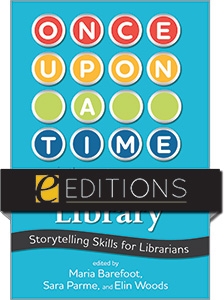
Once Upon a Time in the Academic Library: Storytelling Skills for Librarians—eEditions e-book
The download link for this product can be found on the final confirmation screen after you complete your purchase, and may also be accessed from your Account Profile. For more information about ALA eEditions file types and how to view them on eReaders, desktop computers, and other devices, see this page.
Primary tabs
You don't need to be an ALA Member to purchase from the ALA Store, but you'll be asked to create an online account/profile during checkout to proceed. This Web Account is for both Members and non-Members. Note that your ALA Member discount will be applied at the final step of the checkout process.
If you are Tax-Exempt, please verify that your account is currently set up as exempt before placing your order, as our new fulfillment center will need current documentation. Learn how to verify here.
- Description
- Table of Contents
- About the authors
It could be argued that to tell stories is to be human. Storytelling evolved alongside us to provide entertainment via literature, plays, and visual arts. It helps shape society through parables, moral tales, and religion. Storytelling plays a role in business, law, medicine, and education in modern society.
Academic librarians can apply storytelling in the same way that teachers, entertainers, lawyers, and businesspeople have done for centuries, as education within information literacy instruction and as communication in the areas of reference, outreach, management, assessment, and more. Once Upon a Time in the Academic Library explores applications of storytelling across academic librarianship in three sections:
- The Information Literacy Classroom
- The Stacks
- Physical and Virtual Library Spaces
A thorough introduction discusses the historical and theoretical roots of storytelling, as well as the mechanics and social justice applications. Chapter authors demonstrate using storytelling to share diverse viewpoints that connect with their users, and each chapter contains practical examples of how storytelling can be used within the library and cultural considerations for the audience. The first section focuses on storytelling as a pedagogical tool; the others include examples of how storytelling has been used as a communication method in sharing and developing collections, at service points, and in online spaces. Once Upon a Time in the Academic Library can provide ideas and inspiration for incorporating storytelling into your teaching and communication, and inspire you to invent new ways of using it in your work.
Introduction: The Roots of Storytelling in History, Theory, and Librarianship
Maria Barefoot, Elin Woods, and Sara Parme
Tales from the Information Literacy Classroom
Chapter 1. A Tale of Five Case Studies: Reflections on Piloting a Case-Based, Problem-Based Learning Curriculum in English Composition
Katie Strand, Rachel Wishkoski, Alex Sundt, and Deanna Allred
Chapter 2. Shooting for the Stars: Using a Story Ripped from the Astronomy Headlines with First-Year Students
Kathryn Yelinek
Chapter 3. Encouraging Connections: Using Personal Storytelling in the Information Literacy Classroom
Allyson Wind and Megan Smith
Chapter 4. The Moral of the Story Is… Appealing to Student Values in the Classroom
Gerald R. Natal
Chapter 5. Revealing the Means of (Information) Production: Collaborative Storytelling to Demystify Scholarship
Dunstan McNutt
Tales from the Stacks
Chapter 6. The Depository is Large. It Contains Multitudes
L. E. Eames
Chapter 7. Call and Response: Delicate Conversations in Collection Development
Alexis L. Pavenick
Chapter 8. Choose Your Own Path: Using Primary Sources and Oral History Interviews to Promote Life Experiences Found in Special Collections and University Archives
Harrison Wick
Tales from Physical and Virtual Library Spaces
Chapter 9. Let’s Tell a Story: Narrative, Constructivism, and Accessibility
Anders Tobiason
Chapter 10. Using Existing Fandoms to Create Your Own Library Stories: How a Harry Potter-inspired Murder Mystery Introduced First-Year Students to the Library
Holly Jackson
Biographies
Maria R. Barefoot
Maria R. Barefoot is the online learning librarian at the University of Delaware. She became interested in the connection between storytelling and learning while pursuing her master of education degree from Indiana University of Pennsylvania. She has previously published in Reference Services Review, Pennsylvania Libraries: Research and Practice, and The Library Assessment Cookbook.
Sara Parme
Sara Parme, MLIS, MBA, is the Project Director for the Appalachian College Association’s Open and Affordable Resources Initiative and the Grants Coordinator of PA GOAL, Pennsylvania’s open and affordable grants program. After working in academic libraries for nine years, thanks to the mentors and some wonderful people she’s met along the way, her professional interests are virtual community building, project management, and not reinventing the wheel. She’s always found the open and affordable community to be where the nice people are, and her professional aim is to surround herself with as many nice people as possible. In her previous job evaluations, she’s often described as “informal” and “enthusiastic,” two characteristics she’s chosen to embrace as strengths when meeting new people and challenges. She is currently pursuing her PhD in Administration and Leadership Studies. Her dissertation focuses on status and incivility among academic library employees. She’s a productivity geek and can have lengthy conversations about planners and focus apps.
Elin Woods
Elin Woods is an independent researcher previously holding librarian posts at Saint Francis University and most recently at the Indiana University of Pennsylvania as a student success librarian. Her slightly unconventional path to libraries included time spent working at a newspaper and planning events before pursuing her MLIS from Clarion University. Since then, she has worked in both public and academic libraries, believing that they both have something to learn from one another. Her favorite way to tell stories is in the form of food, as she especially loves baking her way through historical Welsh and northern English cookbooks and the recipes she has from her grandmothers. When she’s not whipping up something in the kitchen, you can find her exploring Appalachia or on the hunt for the perfect red lipstick.


